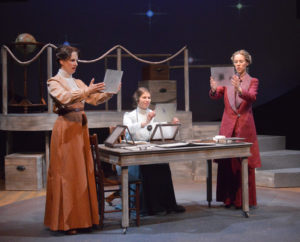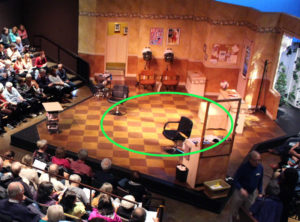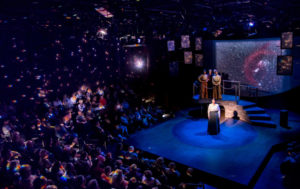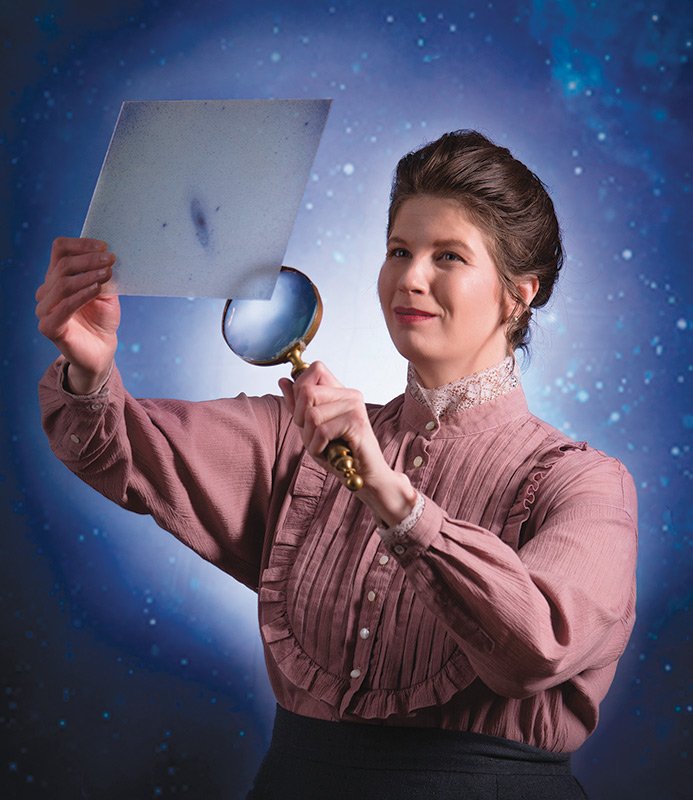Lighting Design, My Creative Process
by Paul Epton
Paul is a professional, live theatre lighting designer and the creator of the design for our version of “Silent Sky” by Lauren Gunderson. In this post, Paul provides a behind the scenes glimpse into his creative process.
 “If you can’t see the actors, it’s my fault” is my usual response when I’m introduced as the lighting designer, but of course my job is so much more. I start with the script. Always the script. Not just the basics—time of day, interior or exterior, season, locale, reality vs. memory vs. dream—but also meaning, emotion, message. I am constantly thinking of the audience and what I can I do to help you feel and understand what the director, creative team, and performers want to share. Ideally, you won’t notice the lighting design as a separate element (at least most of the time) as it enhances the story we’re all trying to tell you.
“If you can’t see the actors, it’s my fault” is my usual response when I’m introduced as the lighting designer, but of course my job is so much more. I start with the script. Always the script. Not just the basics—time of day, interior or exterior, season, locale, reality vs. memory vs. dream—but also meaning, emotion, message. I am constantly thinking of the audience and what I can I do to help you feel and understand what the director, creative team, and performers want to share. Ideally, you won’t notice the lighting design as a separate element (at least most of the time) as it enhances the story we’re all trying to tell you.
After reading the script, it’s time to talk with the director and other designers to get their perspectives. That’s when a whole list of questions must be answered. How realistic will the scenery be? How much work will lighting and props do to define time and place? What will be at the back of the stage: black masking, the sky, a projection surface, or an abstract scenic element? How will video and lighting interact to complement rather than interfere with each other? As the design takes shape, I’ll be thinking about specific cues in terms of how each scene, or moments within scenes, should look. Does the director plan staging that calls for light cues beyond what the script or design concepts require? What about transitions between scenes? Precisely when do the changes start, and how long do they take? Watching rehearsal further informs these choices as I come to a deeper understanding of the play as well as see how the actors use the stage.
Only then will I move on to technical decisions such as which instruments to use, the direction they will point along with what color filter or other effects to utilize. Once the lights are all in place—a 2-3 day process at the start of the 2 weeks leading up to opening—I’ll begin to create the cues for each look of the show. It is through these technical rehearsals that the world is truly created and the further decisions are made. As the actors and director move from rehearsal room to actual set, what needs to change? Should the rate of each change be what I thought, or does it look too fast? Should it start a second later? Do I need to change or move some of the lights? Add others? Add or remove cues? And what do we learn from you, the audience—do we need to hold the action, or the lighting changes, for your reactions? Or give you a moment to absorb what you’ve just heard or seen?
 Last season, one of the dramatic lighting touches I created was the ceiling fan in Steel Magnolias. If it hadn’t been there, nobody would have missed it. A real fan, at a realistic height, would have cast multiple distracting shadows on the actors. Could I do it with lights—the shadow of the fan blades, lazily turning (just how fast?). Just enough to emphasize that it’s a hot summer day, or not turning when it was Christmas.
Last season, one of the dramatic lighting touches I created was the ceiling fan in Steel Magnolias. If it hadn’t been there, nobody would have missed it. A real fan, at a realistic height, would have cast multiple distracting shadows on the actors. Could I do it with lights—the shadow of the fan blades, lazily turning (just how fast?). Just enough to emphasize that it’s a hot summer day, or not turning when it was Christmas.
For Silent Sky, a small moment that changed once we moved into the theatre was at the end of Henrietta’s introductory scene, as she transitions into the scene with her sister Margie. Questions raised in this moment ranged from how the lights should shift at the end of the introductory monologue or wait for Henrietta to move, sit and watch the night sky for a bit, then slowly change to daytime as Margie breaks in. Should I include the sky, which necessarily silhouettes scenery that has nothing to do with the yard in Wisconsin, or leave the backdrop dark since the scene is completely downstage? Through trial and error and feedback from the entire team, those questions are answered.
 One of the big moments in Silent Sky was director Adrienne Sweeney’s early vision for the end of the play, the moment when Henrietta finally looks through the Great Refractor telescope that she was never allowed to use during her time at Harvard. The image Adrienne started with hearkened back to the swags of lights used in The Elephant Man last season and whether or not we could we extend those points of light beyond the confines of the stage to encompass the audience. We tossed around several ideas during early meetings, then I did an experiment at the start of rehearsals. It eventually led to the final result, but even that changed just a day or two before the first preview. We decided to adjust the sequence and timing, but I said “wait a moment” and programmed a slightly different cue sequence than we had just settled on. When I ran my version, the response from the team was “Right! That’s it.” You’ll have to decide if it works for you, too.
One of the big moments in Silent Sky was director Adrienne Sweeney’s early vision for the end of the play, the moment when Henrietta finally looks through the Great Refractor telescope that she was never allowed to use during her time at Harvard. The image Adrienne started with hearkened back to the swags of lights used in The Elephant Man last season and whether or not we could we extend those points of light beyond the confines of the stage to encompass the audience. We tossed around several ideas during early meetings, then I did an experiment at the start of rehearsals. It eventually led to the final result, but even that changed just a day or two before the first preview. We decided to adjust the sequence and timing, but I said “wait a moment” and programmed a slightly different cue sequence than we had just settled on. When I ran my version, the response from the team was “Right! That’s it.” You’ll have to decide if it works for you, too.

 Why did you want to bring your daughter to this play?
Why did you want to bring your daughter to this play?




